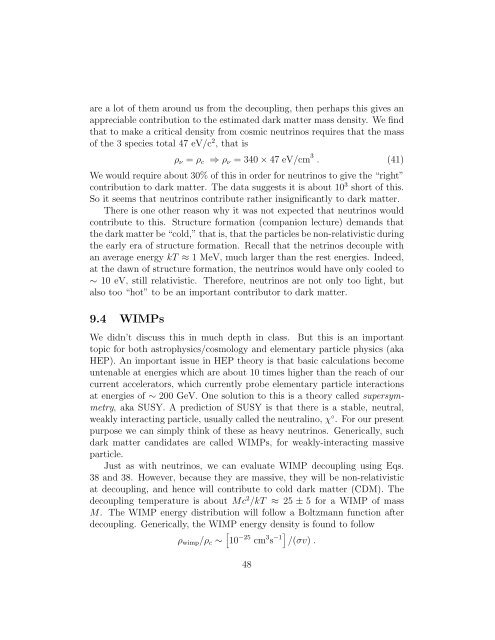Lecture Notes for Astronomy 321, W 2004 1 Stellar Energy ...
Lecture Notes for Astronomy 321, W 2004 1 Stellar Energy ...
Lecture Notes for Astronomy 321, W 2004 1 Stellar Energy ...
You also want an ePaper? Increase the reach of your titles
YUMPU automatically turns print PDFs into web optimized ePapers that Google loves.
are a lot of them around us from the decoupling, then perhaps this gives an<br />
appreciable contribution to the estimated dark matter mass density. We find<br />
that to make a critical density from cosmic neutrinos requires that the mass<br />
of the 3 species total 47 eV/c 2 , that is<br />
ρ ν = ρ c ⇒ ρ ν = 340 × 47 eV/cm 3 . (41)<br />
We would require about 30% of this in order <strong>for</strong> neutrinos to give the “right”<br />
contribution to dark matter. The data suggests it is about 10 3 short of this.<br />
So it seems that neutrinos contribute rather insignificantly to dark matter.<br />
There is one other reason why it was not expected that neutrinos would<br />
contribute to this. Structure <strong>for</strong>mation (companion lecture) demands that<br />
the dark matter be “cold,” that is, that the particles be non-relativistic during<br />
the early era of structure <strong>for</strong>mation. Recall that the netrinos decouple with<br />
an average energy kT ≈ 1 MeV, much larger than the rest energies. Indeed,<br />
at the dawn of structure <strong>for</strong>mation, the neutrinos would have only cooled to<br />
∼ 10 eV, still relativistic. There<strong>for</strong>e, neutrinos are not only too light, but<br />
also too “hot” to be an important contributor to dark matter.<br />
9.4 WIMPs<br />
We didn’t discuss this in much depth in class. But this is an important<br />
topic <strong>for</strong> both astrophysics/cosmology and elementary particle physics (aka<br />
HEP). An important issue in HEP theory is that basic calculations become<br />
untenable at energies which are about 10 times higher than the reach of our<br />
current accelerators, which currently probe elementary particle interactions<br />
at energies of ∼ 200 GeV. One solution to this is a theory called supersymmetry,<br />
aka SUSY. A prediction of SUSY is that there is a stable, neutral,<br />
weakly interacting particle, usually called the neutralino, χ ◦ . For our present<br />
purpose we can simply think of these as heavy neutrinos. Generically, such<br />
dark matter candidates are called WIMPs, <strong>for</strong> weakly-interacting massive<br />
particle.<br />
Just as with neutrinos, we can evaluate WIMP decoupling using Eqs.<br />
38 and 38. However, because they are massive, they will be non-relativistic<br />
at decoupling, and hence will contribute to cold dark matter (CDM). The<br />
decoupling temperature is about Mc 2 /kT ≈ 25 ± 5 <strong>for</strong> a WIMP of mass<br />
M. The WIMP energy distribution will follow a Boltzmann function after<br />
decoupling. Generically, the WIMP energy density is found to follow<br />
ρ wimp /ρ c ∼ [ 10 −25 cm 3 s −1] /(σv) .<br />
48













